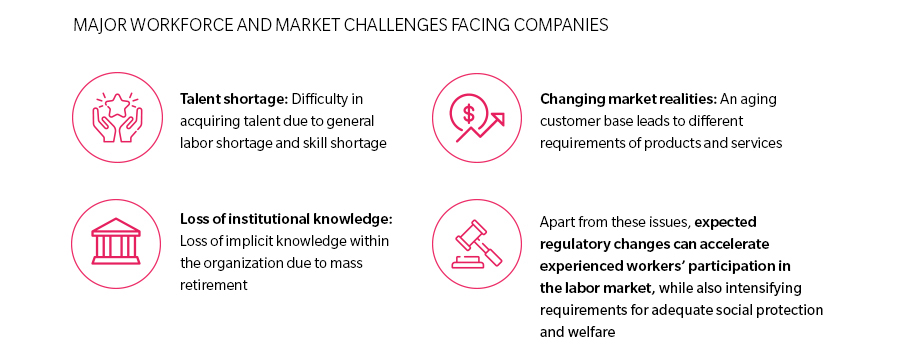Experienced workers can not only plug the talent gap but also represent the best talents in a rising global longevity economy.
The twin trends of rapid population aging and automation are unprecedented in speed and scope, with workers above the age of 50 doing jobs that are at moderate-to-high risk of being replaced by machines. This exacerbates the uncertainty of their employment and can force workers in this demographic into a more precarious financial situation, possibly leading to adverse health effects both physically and socio-psychologically. These are serious issues that have commanded increasing attention from governments through research and public policy – but governmental efforts alone will not be enough.
In this context, companies face a dilemma. On one hand, there are increasing calls for them to be a part of the solution and facilitate adequate social protections to ensure the well-being of experienced workers. On the other hand, companies are under pressure to remain competitive by undergoing digital transformation, which may portend negative developments for this demographic. Absent in these management discussions is any consideration of how these workers can continue to greatly contribute to the organization.
The Twin Trends of Aging and Automation: Leveraging a tech-empowered experienced workforce proposes a new perspective and suggests solutions to the dilemma companies are facing. The report applies a corporate lens to the intersection of aging and automation, arguing that companies must seek to integrate the experienced workforce into their broader strategy to reach greater success.
The key question is: what is the role of new technologies in this vision?
.jpg)
Building the case for an experienced worker-centered strategy
Experienced workers refers to workers above the age of 50 whose tenure within organizations and industries has provided them with a wealth of experience and knowledge that companies can leverage to enhance competitiveness. Traditionally, they have not been considered a viable talent source to close the skills gap. According to the World Economic Forum’s 2016 Future of Jobs report, only 4 percent of respondents planned on investing in experienced workers as part of their workforce strategy for the future. Why is this?
- Population aging has yet to become a serious problem in a large number of markets
- The economic case for retaining and retraining this demographic may not be compelling, and can run counter to a company’s automation ambitions
- Misconceptions about experienced workers’ aptitude and ability to contribute lead to ageism and severely undermine the economic case for an experienced worker strategy
However, rapidly aging populations and falling birthrates have made neglecting the experienced workforce unsustainable. Companies today face a number of challenges that together present a compelling economic case for a proactive experienced workforce strategy.

In addition to helping companies cope with talent shortage, loss of institutional knowledge, or new regulatory demands, a strategy centered on experienced workers affords companies the opportunity to advantageously reposition themselves in the rising global ‘longevity economy.’
.jpg)
Leveraging a tech-empowered experienced workforce
The key challenge for executives is to integrate new technology and successfully digitalize while ensuring a motivated, productive, and healthy experienced workforce. While research has pointed to the myriad ways in which technology can be deployed to this end; technology, itself, cannot be treated as an all-purpose solution that can be easily bolted on. The organization must change as well in order to anticipate and leverage technological transformation.
To this end, it is important to identify, promote, and facilitate areas of tech-human synergy. The strategy house below lays out how technology can potentially be integrated to augment experienced workers and, likewise, where the rich knowledge that experienced workers hold can make technology more effective.
Two integral parts of the framework: Technological integration and an inclusive organizational culture. The introduction of new technologies will change the nature of work and talent management. As such, resources should be devoted to redesigning jobs and talent models in a way that is compatible with—and indeed, best leverage—experienced workers. But change cannot be implemented without a unified vision and support from the wider organization. Building an age-friendly, diverse, and inclusive environment is key to retaining and enabling experienced workers, thus forming the base of this strategy.
.jpg)
The Twin Trends of Aging and Automation: Leveraging a tech-empowered experienced workforce is the follow-up to our first Aging and Automation report, which examined how automation impacts workers above the age of 50 across 15 major markets. Both reports are part of Marsh & McLennan’s Workforce for the Future research, focusing on how megatrends in technologies will impact the workplace.






